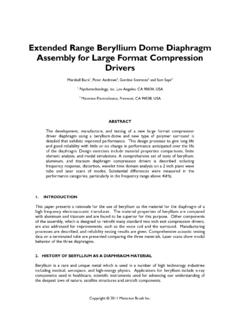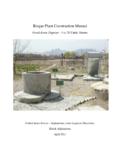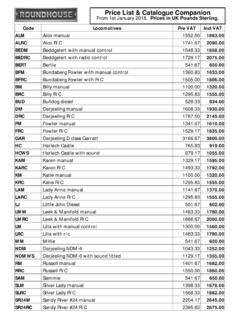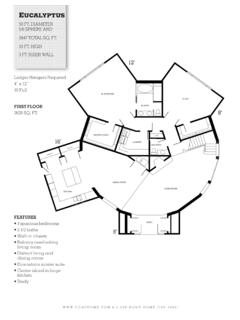Transcription of 4. FIFA World Cup stadiums - Play the Game - Home
1 27 4. fifa World Cup stadiums fifa has a number of requirements for stadiums hosting World Cup games. One of these is capacity. fifa requires that a venue hosting the opening game and the final must have a net capacity of at least 80,000. For the other group matches, last 16, quarter finals and the match for third place the requirement is at least 40,000, and fifa requests a net capacity of at least 60,000 for venues hosting the At the first fifa World Cup for men, which was held in Uruguay in 1930, 13 teams participated. Over time, the number of teams has increased and, as mentioned in chapter 1, the number of participating countries had become 32 by the World Cup in France in 1998.
2 The increase in participating teams has, as stated above, not resulted in more stadiums being built, and figure below shows that the number of World Cup stadiums has been 9-12 per venue per event regardless of whether 24 or 32 countries took part in the finals. The exception is the 2002 World Cup in Korea/Japan where 20 stadiums were used. Figure : Number of fifa World Cup stadiums 1990-2022 For future World Cups, the number of venues is also about the same. fifa advised applicants for the World Cup in 2018 and 2022 that 16-18 venues should be presented in each application, venues which, in a reasonable manner, should be spread all over the country. Of these 16-18 stadiums fifa would then choose 12 The majority of the stadiums used for the 2018 World Cup in Russia and 2022 in 44 45 Ibid.
3 1291020121012121205101520251990199419982 00220062010201420182022 Number of Venues 28 Qatar will be newly built. Brazil anticipates six new stadiums and major renovations to four others for its World Cup in 2014. As figure shows below, the number of venues that have been constructed or undergone major renovations varies from event to event. Before the 1998 World Cup in France, fifa decided to only allow all-seater stadiums . France built one new stadium while five underwent major renovations partly due to these requirements. The all-seater stadium requirements were introduced eight years before when Italy hosted the World Cup and despite the former requirements Italy had to make significant investments to be able to host the event.
4 11 new stadiums were built or underwent major renovations for the event. Since 1990 the majority of these Word Cup venues have not undergone any significant renovations. As figure shows, the 1994 World Cup in the United States took place without any new stadiums being built or major renovations being carried out. Thanks to a major interest in American football in the state, on both a professional and college level, USA could organise the event without any significant stadium investments. Figure : Number of new or major renovations to stadiums due to the fifa World Cup 2002 fifa World Cup in Korea/Japan The total cost of the 19 new or renovated stadiums for the 2002 fifa World Cup was just over $ bn. resulting in an average price of $243 million per venue. As figures and show, the World Cup in Korea/Japan so far has the highest number of used venues and also the highest number of new or renovated venues due to the event.
5 The main reason for the many venues is that the two countries initially intended to apply for the World Cup individually. However, the two countries eventually decided to make a joint application and were awarded the event in 1996. 1106191061012120246810121416182019901994 1998200220062010201420182022 Number of venues 29 Miyagi Stadium, Rifu in Japan Construction price: 318 million Capacity: 49,133 Attendance in 2010: 73,767 World Stadium Index: After the 2002 World Cup a number of venues in Japan have faced difficulties in attracting larger crowds. One of these venues is Miyagi Stadium. The stadium, with a capacity of 49,133 and construction costs of almost $320 million, hosted two group matches and one last 16 match during the event.
6 Miyagi Stadium staged nearly 80 events, but had only 73,767 spectators in total in 2010, which is a poor figure for a stadium of Miyagi Stadium's capacity. Another major problem is that the two big teams in the prefecture, Vegalta Sendai and Tohoku Rakuten Golden Eagles, have chosen to play their home games at other venues venues that existed before the Miyagi Stadium was built. Both teams attracted larger attendance figures than the events at Miyagi Stadium did in 2010. The football team, Vegalta Sendai, chose to play a majority of their home games at the much smaller venue Yurtec Stadium Sendai, which has seating for 20,000 spectators. In 2010 the team had an average audience of 17,33246 and played only three matches in the J-League at Miyagi Stadium. The baseball team in the prefecture (subnational jurisdiction), Tohoku Rakuten Golden Eagles, plays its home games at Miyagi Baseball Stadium, which has a capacity of 23,026 spectators, and had an average attendance of 15,876 in The two teams have similar average attendance figures, but while Tohoku Rakuten Golden Eagles play at least 72 matches at home per season, their total attendance figures are just over million, which results in a higher total attendance figure than Vegalta Sendai.
7 Miyagi Stadium needs a high profile anchor tenant if the stadium is going to increase its attendance figures. Its few major sporting events per year are not enough and the sporting legacy of the stadium is questionable. The local stadium need was fulfilled before 2002 World Cup and the new stadium has not been a boost for sport in the prefecture. Sapporo Dome, Sapporo in Japan Construction price: 426 million Capacity: 42,328 Attendance in 2010: 1,965,944 (only baseball and soccer) World Stadium Index: 46 47 30 Not all stadiums built for the 2002 World Cup have had a problematic sporting legacy. One example is Sapporo Dome on the island of Hokkaido.
8 Although the stadium had a relatively high investment cost, just over $426 million, due to its multi-functionality and roof, this has made it possible for the venue to host different types of events. Significant events that have taken place in the stadium after the World Cup exemplifying the venue s multi-functionality are the sprint races in the 2007 FIS Nordic World Ski Championship and a special stage of Rally Japan in 2008 and 2010. In 2010 the stadium hosted 118 events and the majority of these were sporting events. The local baseball team, Hokkaido Nippon-Ham Fighters, played 72 games at Sapporo Dome. The stadium s other main tenant, football team Consadole Sapporo, play at the venue on match days that do not clash with Hokkaido Nippon Ham-Fighters. Consadole Sapporo played eleven games in the J-League at the venue during the 2010 season.
9 The Hokkaido Nippon-Ham and Consadole Sapporo s games alone gave Sapporo Dome a total attendance figure of over two million in the 2010 season. The total figure for the stadium is higher, but we lack the figures from the other events. Conclusion on 2002 fifa World Cup in Korea/Japan Unfortunately, we lack data on the total attendance numbers for the Korean stadiums built for fifa World Cup 2002, which means that is impossible to give an overall picture of the sporting legacy for the 2002 World Cup venues. Desk research indicates that Korea spent nearly $ bn. on its stadiums . The equivalent figure for Japan was just over $ bn. Table : Overview 2002 fifa World Cup stadiums Name Construction Price Price per Seat Total Attendance World Stadium Index Ecopa Stadium, Fukuroi City (JPN) $300,837,055 $5,859 184,296 Kashima Soccer Stadium, Kashima (JPN) $194,968,272 $4,787 415,273 Miyagi Stadium, Rifu (JPN) $317,965,217 $6,472 73,767 Nissan Stadium, Yokohama (JPN) $621,135,687 $8,588 541,047 Ooita Bank Dome, Ooita (JPN) $202,549,576 $5,064 535,516 Saitama Stadium, Saitama (JPN)
10 $359,630,596 $5,646 882,182 31 Misaki Park Stadium, Kobe (JPN) $232,345,610 $7,711 242,979 Sapporo Dome, Sapporo (JPN) $426,303,684 $10,071 1,965,944 Tohoku Denryoku Big Swan Stadium, Niigata (JPN) $283,348,305 $6,699 572,099 Busan Asiad Stadium, Busan (KOR) $223,623,410 $4,159 N/A N/A Daegu Stadium, Daegu (KOR) $293,203,898 $4,414 N/A N/A Daejeon World Cup Stadium, Daejeon (KOR) $141,821,986 $3,499 N/A N/A Gwangju World Cup Stadium, Gwangju (KOR) $156,506,820 $4,090 N/A N/A Incheon Munhak Stadium, Incheon (KOR) $121,402,939 $2,562 N/A N/A Jeju World Cup Stadium, Seogwipo (KOR) $124,426,864 $3,660 N/A N/A Jeonju World Cup Stadium, Jeonju (KOR) $131,177,945 $3,144 N/A N/A Seoul World Cup Stadium, Seoul (KOR) $197,111,864 $2,951 N/A N/A Suwon World Cup Stadium, Suwon (KOR)








